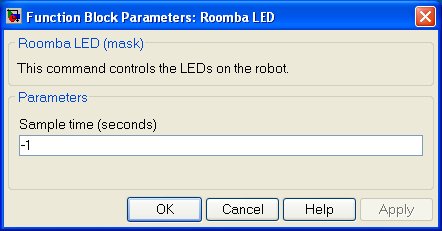

Roomba LED
Controls the LEDs on Roomba.
Library
QUARC Targets/Devices/Third-Party/iRobot/Roomba/Interfacing MATLAB Command Line Click to copy the following command line to the clipboard. Then paste it in the MATLAB Command Window: qc_open_library('quarc_library/Devices/Third-Party/iRobot/Roomba/Interfacing')
Description

The Roomba LED block controls the LEDs on Roomba. It takes three inputs. The first input specifies the following bit pattern to control the states (on/off) of Play and Advance LEDs:
|
Bit |
LED |
|---|---|
|
7 |
- |
|
6 |
- |
|
5 |
- |
|
4 |
- |
|
3 |
Advance |
|
2 |
- |
|
1 |
Play |
|
0 |
- |
Advance and Play buttons use green LEDs. Power button uses a bicolor (red/green) LED. The intensity and color of Power LED are controlled by the second and third inputs. Input 2 varies from 0 to 255, where 0 and 255 specify green and red color, respectively. Intermediate values are intermediate colors (orange, yellow, etc). Input 3 varies from 0 to 255, where 0 and 255 specify off and full intensity, respectively. Intermediate values are intermediate intensities.
This command is available in Safe, or Full operating mode of Roomba (see Roomba Modes block). Execution of this command does not change current Roomba operating mode.
Important Notes
 Use System Timebase
block in Normal simulation.
Use System Timebase
block in Normal simulation.
Input Ports
rmb
A reference to the Roomba stream (see Roomba Initialize block).
bits
8-bit unsigned value (0 to 10) that controls the on/off states of Advance and Play LEDs.
color
8-bit unsigned value (0 to 255) that controls the color of Power LED.
intensity
8-bit unsigned value (0 to 255) that controls the intensity of Power LED.
Output Ports
rmb
A reference to the Roomba stream, which is the same as input Roomba stream reference. It helps creating a daisy chain of Roomba blocks.
err
This signal returns a negative value in case of memory allocation error or data communication error through Roomba serial port.
Parameters and Dialog Box

Sample time
The sample time of the block. A sample time of 0 indicates that the block will be treated as a continuous time block. A positive sample time indicates that the block is a discrete time block with the given sample time. A sample time of -1 indicates that the block inherits its sample time.
Targets
|
Target Name |
Compatible* |
Model Referencing |
Comments |
|---|---|---|---|
|
Yes |
Yes |
||
|
Yes |
Yes |
||
|
Yes |
Yes |
||
|
Yes |
Yes |
||
|
Yes |
Yes |
||
|
Yes |
Yes |
||
|
Yes |
Yes |
||
|
Yes |
Yes |
||
|
Yes |
Yes |
||
|
Yes |
Yes |
||
|
Yes |
Yes |
||
|
Yes |
Yes |
||
|
Yes |
Yes |
||
|
Yes |
Yes |
Last fully supported in QUARC 2018. |
|
|
Rapid Simulation (RSIM) Target |
Yes |
Yes |
|
|
S-Function Target |
No |
N/A |
Old technology. Use model referencing instead. |
|
Normal simulation |
Yes |
Yes |
Use System Timebase. |

Copyright ©2025 Quanser Inc. This page was generated 2025-11-01. Submit feedback to Quanser about this page.
Link to this page.